Global Boiler Market Forecast
- The approximately US$95.2 Bn market for boilers (2023) eyes a valuation of US$135.7 Bn by the end of 2030.
- Boilers market size is poised to grow at a CAGR of 5.2% between 2023 and 2030.
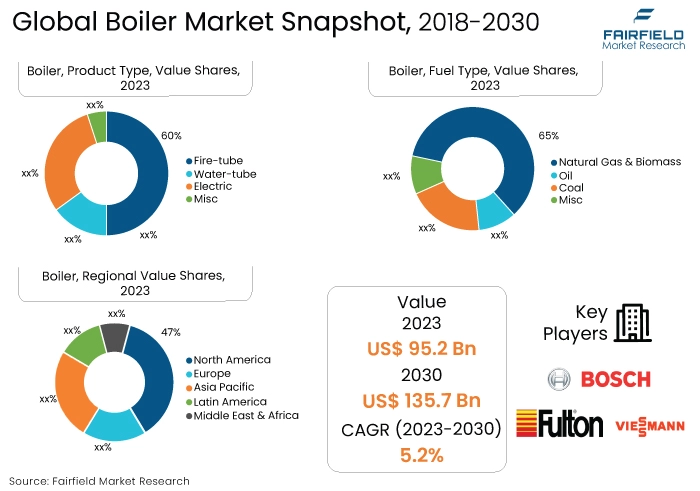
Quick Report Digest
- The boiler market is growing due to increasing demand for energy-efficient heating solutions across industries. Rising industrialisation, coupled with stringent regulations promoting cleaner technologies, fuels the adoption of modern boilers. Additionally, the expanding residential and commercial construction sectors contribute to the market's growth as boilers become essential for space heating and hot water applications.
- Another major market trend expected to fuel the growth of the boiler market is the rapidly expanding chemical and petrochemical industry. The market is also predicted to profit from the expanding worldwide Paper and pulp industries.
- The fire-tube product type is growing in the boiler market due to its simplicity, cost-effectiveness, and versatility. These boilers are widely used in various applications, providing efficient heat transfer and easy maintenance. Their straightforward design, reliability, and adaptability make fire-tube boilers a preferred choice, contributing to their increasing demand in the market.
- The natural gas and biomass fuel type is growing in the boiler market due to a shift towards cleaner and sustainable energy sources, and with an emphasis on environmental regulations and renewable energy adoption, natural gas and biomass offer low-emission and renewable alternatives, driving their increased use in boilers across various industries.
- The chemical and petrochemical end-users are growing in the boiler market due to increasing demand for reliable and efficient steam generation in these industries. Boilers play a vital role in various processes, such as refining and chemical production, where precise temperature control and steam quality are critical, contributing to the sector's growing reliance on boilers.
- Industrialisation, and urbanisation drive the boiler market as expanding industrial and urban developments demand efficient heating and power solutions. Boilers play a vital role in various industrial processes and urban infrastructure, meeting the escalating need for reliable and energy-efficient steam generation in manufacturing, power generation, and heating applications.
- North America is growing in the boiler market due to industrial expansion, technological advancements, and a focus on energy efficiency. Stringent environmental regulations propel the adoption of modern boilers. Additionally, the replacement of ageing infrastructure and the demand for sustainable heating solutions contribute to the region's robust growth in the boiler industry.
- The Asia Pacific region is growing in the boiler market due to rapid industrialisation, urbanisation, and increasing energy demand. Booming economies, particularly in China, and India, drive the construction and manufacturing sectors, necessitating efficient heating solutions. The adoption of advanced boilers to meet these demands contributes to the region's significant market growth.
A Look Back and a Look Forward - Comparative Analysis
The boiler market is growing due to increased industrialisation, urbanisation, and a global focus on energy efficiency. Stringent environmental regulations, technological advancements, and the need for sustainable heating solutions contribute to market expansion.
Boilers play a vital role in various industries, meeting the demand for reliable and efficient steam generation. Replacement of ageing infrastructure, economic growth, and rising awareness of environmental concerns further drive the growth of the boiler market across diverse applications.
The market witnessed staggered growth during the historical period 2018 - 2022. This is due to the substantial growth of major applications such as chemicals, petrochemicals, and paper and pulp. However, in some applications, the demand for boilers has increased, including in Food & Beverages and other areas.
The future of the boiler market is promising, with a continued focus on energy efficiency, environmental sustainability, and technological advancements. As industries evolve, boilers will play a crucial role in meeting the growing demand for reliable and cleaner energy solutions. Integration of smart technologies and renewable energy sources will likely shape the market's trajectory, ensuring boilers remain central to diverse industrial, commercial, and residential applications.
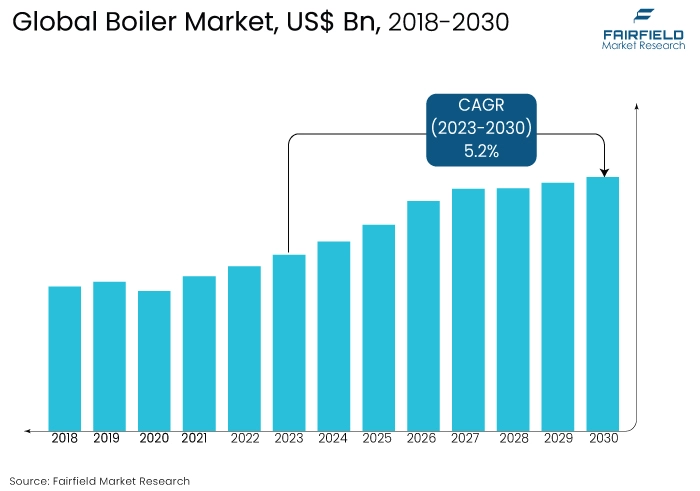
Key Growth Determinants
- Growing Rates of Industrialisation, and Urbanisation
Growing industrialisation and urbanisation are driving the boiler market as expanding urban areas and industrial facilities demand efficient heating and power solutions. Boilers play a pivotal role in meeting the escalating need for steam generation across diverse applications in manufacturing, power generation, and district heating.
The rise in infrastructure projects, manufacturing activities, and increasing energy demands in urban environments contribute to the market's growth. Moreover, as industries become more advanced, the demand for technologically sophisticated and environmentally friendly boilers rises, propelling innovation in the sector and further fueling the momentum of the boiler market.
- Energy Efficiency Regulations
The growing focus on energy efficiency regulations is driving the boiler market as governments worldwide implement stringent standards to reduce energy consumption and environmental impact. Boilers meeting these regulations gain prominence, fostering the adoption of modern and high-efficiency models.
The push for cleaner technologies, lower emissions, and reduced fuel consumption propels the development and deployment of energy-efficient boilers. As industries and commercial establishments seek to comply with these regulations, the demand for advanced boilers that align with sustainability goals and ensure cost savings continues to rise, thereby influencing the positive growth trajectory of the boiler market.
- Growing Renewable Energy Integration
The growing integration of renewable energy is driving the boiler market as industries seek cleaner and sustainable solutions. The shift toward renewable fuels, such as biomass, increases the adoption of biomass-fired boilers, aligning with global efforts to reduce carbon footprints.
Government incentives and environmental awareness further drive the integration of renewable energy sources in boiler systems.
As the demand for eco-friendly and low-emission technologies rises, boilers capable of utilising renewable energy contribute significantly to the market's growth. This trend reflects a broader commitment to transitioning to cleaner energy sources, promoting environmental responsibility, and influencing the evolving landscape of the boiler market positively.
Major Growth Barriers
- High Initial Costs
High initial costs pose a challenge in the boiler market as the upfront investment for modern and energy-efficient boilers can be a deterrent. Businesses, particularly smaller enterprises or those in regions with budget constraints, may hesitate to adopt these advanced systems.
Overcoming the financial barrier and demonstrating the long-term cost benefits of energy-efficient boilers are crucial aspects. Manufacturers and policymakers need to work on strategies such as incentives, financing options, and clear communication of the return on investment to encourage broader adoption and address the challenge of high initial costs.
- Complex Regulations
Complex regulations present a challenge in the boiler market as manufacturers and users must navigate diverse and evolving standards for emissions, safety, and energy efficiency. Compliance with these regulations demands continuous monitoring and adaptation, potentially leading to increased development and operational costs.
Manufacturers face the challenge of meeting varying standards across different regions. Users may need help understanding and implementing complex compliance measures. Simplifying and harmonising regulations, coupled with effective communication and support mechanisms, are crucial for mitigating these challenges and ensuring a smoother regulatory landscape for the boiler market.
Key Trends and Opportunities to Look at
- Digitalisation and IoT Integration
The integration of digital technologies and the Internet of Things (IoT) for remote monitoring, predictive maintenance, and optimisation of boiler performance.
- Smart Boiler Controls
Advanced control systems and automation for enhanced operational efficiency, safety, and real-time adjustments based on varying conditions.
- High-Efficiency Condensing Boilers
Increasing adoption of condensing boilers that recover waste heat, improving overall energy efficiency, and reducing environmental impact.
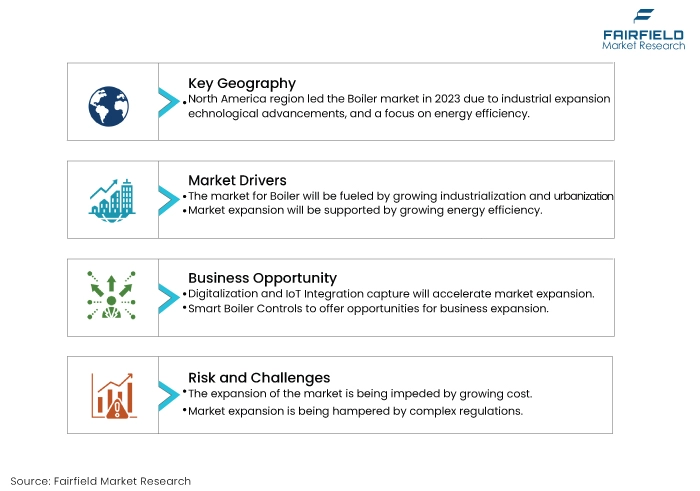
How Does the Regulatory Scenario Shape this Industry?
The boiler market is influenced by various regulatory frameworks globally. In the United States, the Environmental Protection Agency (EPA) enforces regulations like the Clean Air Act, impacting emissions standards for boilers. In the European Union, the Ecodesign Directive sets energy efficiency requirements for heating products, including boilers. China has specific regulations on boiler efficiency and emissions.
Region-specific changes may include updates to emission standards, efficiency requirements, and safety regulations affecting the manufacturing, installation, and operation of boilers. Compliance with these regulations is crucial for market players to ensure market access and meet sustainability goals. Regular monitoring of regulatory developments is essential for adapting to evolving standards and maintaining competitiveness in the boiler market.
Fairfield’s Ranking Board
Segmentation Outlook
- Fire-tube Boilers Top-Selling
The fire-tube product type captured the largest market share in the boiler market due to its simplicity, cost-effectiveness, and versatility. These boilers have a straightforward design with tubes containing hot gases, making them suitable for various applications. They are widely used in small and medium-scale applications, including residential heating and some industrial processes.
The ease of maintenance and lower upfront costs contribute to their popularity, especially in regions where these factors weigh heavily in the decision-making process, leading to the Fire-tube product type dominating the market share.
With their clean and efficient operation, electric boilers emerge lucrative in the global market for boilers. These boilers offer precise temperature control, are compact, and produce zero emissions on-site. With increasing emphasis on sustainability, the demand for electric boilers rises. They find applications in diverse sectors, including residential, commercial, and industrial, contributing to their rapid growth.
Additionally, advancements in electric boiler technologies, such as improved energy efficiency and integration with smart controls, further propel their adoption and position them with the highest CAGR in the market.
- Natural Gas & Biomass Remains the Top Fuel Type Segment
The natural gas and biomass fuel types captured the largest market share in the boiler market due to their dual advantages of being a cleaner-burning fossil fuel and a renewable energy source. Natural gas offers efficiency and lower emissions, aligning with environmental regulations. The inclusion of biomass enhances sustainability.
As the demand for environmentally friendly solutions grows, natural gas and biomass fuel types gain prominence. Its versatility, reliability, and reduced environmental impact contribute to its dominance in the market, meeting the evolving needs of industries and supporting a transition to greener energy sources.
The growth of oil as another strong fuel type segment in the boiler market may be attributed to its widespread use in various industrial applications, particularly in regions where oil is readily available. Factors such as energy security, reliability, and the existing infrastructure for oil-fired systems could contribute to its growth.
- Chemicals & Petrochemicals Lead Adoption, Demand from F&B Soars
The chemical and petrochemical industries capture the largest market share of the boiler industry due to the critical role boilers play in the industry's various processes. Boilers are essential for heating, steam generation, and maintaining precise temperature control in chemical and petrochemical manufacturing.
As these sectors often involve complex and energy-intensive processes, reliable and efficient boiler systems are integral. The demand for high-performance boilers to meet stringent operational requirements in these industries contributes to their dominance in the market, addressing the specific needs of the chemical and petrochemical end-users.
The F&B industry however is set to be witnessing a rapid CAGR in the market soon as creates growing demand for steam, and hot water in various food processing and beverage manufacturing applications.
Boilers play a crucial role in tasks such as cooking, sterilisation, and cleaning in the industry. As the Food and beverages sector expands globally, the need for reliable and energy-efficient boiler systems rises, driving their adoption and contributing to the sector's highest CAGR in the market.
Regional Frontrunners
- Energy Efficiency Dictates North America’s Leadership Position
North America has captured the largest market share in the boiler market due to several factors. The region's well-established industrial base, along with a mature infrastructure, drives the demand for boilers across diverse applications, including manufacturing, power generation, and heating. Stringent environmental regulations promote the adoption of modern and cleaner technologies, supporting the growth of advanced boiler systems.
Additionally, ongoing efforts to upgrade ageing infrastructure contribute to market dominance. The presence of key market players, technological advancements, and a focus on energy efficiency further enhance North America's position, making it the leading contributor to the boiler market's market share.
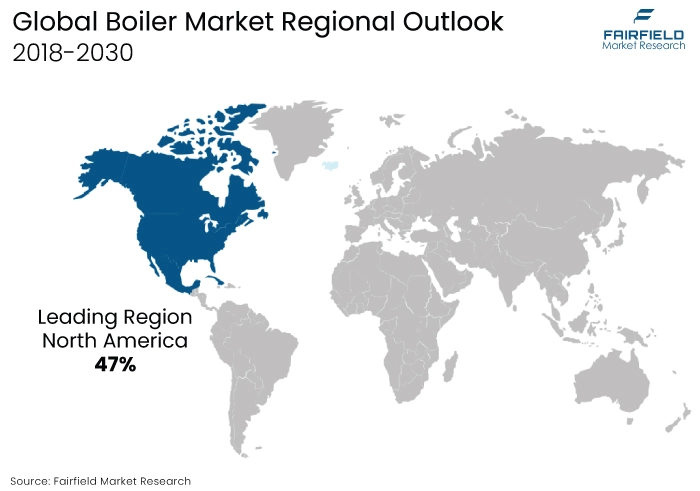
- Asia Pacific Set to Benefit from Growing Application in Optoelectronics
Asia Pacific continues to gain significantly from rapid industrialisation, urbanisation, and increasing energy demand. Booming economies, particularly in China, and India, drive the construction and manufacturing sectors, necessitating efficient heating solutions.
The adoption of advanced boilers to meet these demands contributes to the region's significant market growth. The expanding consumer electronics market, and growing applications in optoelectronics contribute toward a remarkable CAGR projected for the region, positioning the Asia Pacific region as a key growth engine for the boiler market.
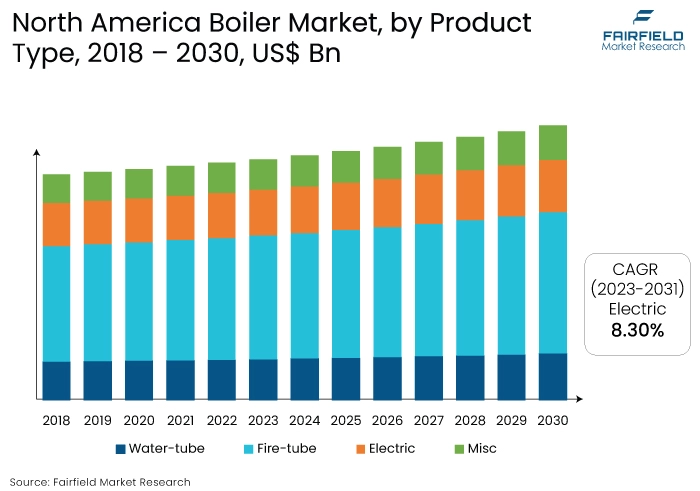
Fairfield’s Competitive Landscape Analysis
The presence of key players such as General Electric Company, Siemens AG, Bosch Thermotechnology, and Fulton Boiler Works, Inc. Intense competition centres on innovation, energy efficiency, and adherence to environmental standards characterises the competitive landscape of the boiler market.
Strategic collaborations, mergers, and acquisitions contribute to market consolidation. Players emphasize global expansion, product diversification, and digitalisation to gain a competitive edge. Customer-centric approaches and a focus on sustainable technologies are pivotal in establishing a strong market presence amid evolving industry dynamics.
Who are the Leaders in the Global Boiler Space?
- Bosch Thermotechnology
- Viessmann Werke GmbH & Co KG
- Fulton Boiler Works, Inc.
- Hurst Boiler & Welding Co., Inc.
- Cleaver-Brooks, Inc.
- Mitsubishi Hitachi Power Systems, Ltd.
- Babcock & Wilcox Enterprises, Inc.
- Alfa Laval AB
- Thermax Limited
- Suzhou Hailu Heavy Industry Co., Ltd.
- Clayton Industries
- Harbin Electric Company Limited
- Rentech Boiler Systems, Inc.
- Johnston Boiler Company
- Byworth Boilers Limited
Significant Industry Developments
New Product Launch
- April 2022: Fulton launched the latest classic vertical steam boiler in the United Kingdom. The Classic model is offered with gas, oil, or LPG/Propane burners, featuring outputs ranging from 100kW to 300kW (160 to 480kg/h) at 10.34 Barg with efficiencies reaching up to 84 percent. The full steam output is attainable within 20 minutes from a cold start, highlighting the capability of Classic steam boilers to meet the rapid steam needs across diverse industrial applications, such as pharmaceutical, healthcare, food, and beverage industries.
An Expert’s Eye
Demand and Future Growth
An increase in consumer demand for chemicals and petrochemicals is driving the market. The boiler Market is driven by growing demand for efficient heating solutions in industrial, commercial, and residential sectors. Future growth is anticipated due to ongoing industrialisation, urbanisation, and the need for energy-efficient technologies.
As industries emphasize sustainability, the market is expected to witness increased adoption of advanced and environmentally friendly boiler systems. Technological innovations, such as smart controls and renewable energy integration, will further influence demand.
The evolving regulatory landscape, aimed at reducing emissions and enhancing energy efficiency, will shape the market's future growth trajectory, responding to the dynamic requirements of diverse applications.
Supply Side of the Market
Industrialisation, regulations, and technological advancements influence the demand-supply dynamics in the boiler market. Current pricing structures reflect the costs of raw materials, manufacturing, and compliance with environmental standards. Pricing will impact long-term growth as competitive pricing strategies, innovations, and energy efficiency drive market adoption.
Major trends driving competition include the shift to cleaner energy sources, digitalisation, and modular boiler systems. A resilient supply chain is crucial, involving raw material sourcing, manufacturing, and distribution.
The integration of Industry 4.0 technologies enhances supply chain efficiency. Market players focusing on sustainability, technological advancements, and strategic collaborations will be well-positioned to navigate and succeed in the dynamic landscape of the boiler Market.
Global Boiler Market is Segmented as Below:
By Product Type:
- Fire-tube
- Water-tube
- Electric
- Misc
By Fuel Type:
- Natural Gas & Biomass
- Oil
- Coal
- Misc
By End-Use Industry:
- Chemicals & Petrochemicals
- Paper & Pulp
- Food & Beverages
- Metals & Mining
- Power Generation
- Oil & Gas
- Misc
By Geographic Coverage:
- North America
- U.S.
- Canada
- Europe
- Germany
- U.K.
- France
- Italy
- Turkey
- Russia
- Rest of Europe
- Asia Pacific
- China
- Japan
- South Korea
- India
- Southeast Asia
- Rest of Asia Pacific
- Latin America
- Brazil
- Mexico
- Argentina
- Rest of Latin America
- Middle East & Africa
- GCC
- South Africa
- Egypt
- Nigeria
- Rest of the Middle East & Africa
1. Executive Summary
1.1. Global Boiler Market Snapshot
1.2. Future Projections
1.3. Key Market Trends
1.4. Regional Snapshot, by Value, 2022
1.5. Analyst Recommendations
2. Market Overview
2.1. Market Definitions and Segmentations
2.2. Market Dynamics
2.2.1. Drivers
2.2.2. Restraints
2.2.3. Market Opportunities
2.3. Value Chain Analysis
2.4. Porter’s Five Forces Analysis
2.5. Covid-19 Impact Analysis
2.5.1. Supply
2.5.2. Demand
2.6. Impact of Ukraine-Russia Conflict
2.7. Economic Overview
2.7.1. World Economic Projections
2.8. PESTLE Analysis
3. Global Boiler Market Outlook, 2018 - 2030
3.1. Global Boiler Market Outlook, by Product Type, Value (US$ Mn), 2018 - 2030
3.1.1. Key Highlights
3.1.1.1. Fire-tube
3.1.1.2. Water-tube
3.1.1.3. Electric
3.1.1.4. Misc
3.2. Global Boiler Market Outlook, by Fuel Type, Value (US$ Mn), 2018 - 2030
3.2.1. Key Highlights
3.2.1.1. Natural Gas & Biomass
3.2.1.2. Oil
3.2.1.3. Coal
3.2.1.4. Misc
3.3. Global Boiler Market Outlook, by End-use, Value (US$ Mn), 2018 - 2030
3.3.1. Key Highlights
3.3.1.1. Chemicals & Petrochemicals
3.3.1.2. Paper & Pulp
3.3.1.3. Food & Beverages
3.3.1.4. Metals & Mining
3.3.1.5. Power Generation
3.3.1.6. Oil & Gas
3.3.1.7. Misc
3.4. Global Boiler Market Outlook, by Region, Value (US$ Mn), 2018 - 2030
3.4.1. Key Highlights
3.4.1.1. North America
3.4.1.2. Europe
3.4.1.3. Asia Pacific
3.4.1.4. Latin America
3.4.1.5. Middle East & Africa
4. North America Boiler Market Outlook, 2018 - 2030
4.1. North America Boiler Market Outlook, by Product Type, Value (US$ Mn), 2018 - 2030
4.1.1. Key Highlights
4.1.1.1. Fire-tube
4.1.1.2. Water-tube
4.1.1.3. Electric
4.1.1.4. Misc
4.2. North America Boiler Market Outlook, by Fuel Type, Value (US$ Mn), 2018 - 2030
4.2.1. Key Highlights
4.2.1.1. Natural Gas & Biomass
4.2.1.2. Oil
4.2.1.3. Coal
4.2.1.4. Misc
4.3. North America Boiler Market Outlook, by End-use, Value (US$ Mn), 2018 - 2030
4.3.1. Key Highlights
4.3.1.1. Chemicals & Petrochemicals
4.3.1.2. Paper & Pulp
4.3.1.3. Food & Beverages
4.3.1.4. Metals & Mining
4.3.1.5. Power Generation
4.3.1.6. Oil & Gas
4.3.1.7. Misc
4.3.2. BPS Analysis/Market Attractiveness Analysis
4.4. North America Boiler Market Outlook, by Country, Value (US$ Mn), 2018 - 2030
4.4.1. Key Highlights
4.4.1.1. U.S. Boiler Market by Product Type, Value (US$ Mn), 2018 - 2030
4.4.1.2. U.S. Boiler Market Fuel Type, Value (US$ Mn), 2018 - 2030
4.4.1.3. U.S. Boiler Market End-use, Value (US$ Mn), 2018 - 2030
4.4.1.4. Canada Boiler Market by Product Type, Value (US$ Mn), 2018 - 2030
4.4.1.5. Canada Boiler Market Fuel Type, Value (US$ Mn), 2018 - 2030
4.4.1.6. Canada Boiler Market End-use, Value (US$ Mn), 2018 - 2030
4.4.2. BPS Analysis/Market Attractiveness Analysis
5. Europe Boiler Market Outlook, 2018 - 2030
5.1. Europe Boiler Market Outlook, by Product Type, Value (US$ Mn), 2018 - 2030
5.1.1. Key Highlights
5.1.1.1. Fire-tube
5.1.1.2. Water-tube
5.1.1.3. Electric
5.1.1.4. Misc
5.2. Europe Boiler Market Outlook, by Fuel Type, Value (US$ Mn), 2018 - 2030
5.2.1. Key Highlights
5.2.1.1. Natural Gas & Biomass
5.2.1.2. Oil
5.2.1.3. Coal
5.2.1.4. Misc
5.3. Europe Boiler Market Outlook, by End-use, Value (US$ Mn), 2018 - 2030
5.3.1. Key Highlights
5.3.1.1. Chemicals & Petrochemicals
5.3.1.2. Paper & Pulp
5.3.1.3. Food & Beverages
5.3.1.4. Metals & Mining
5.3.1.5. Power Generation
5.3.1.6. Oil & Gas
5.3.1.7. Misc
5.3.2. BPS Analysis/Market Attractiveness Analysis
5.4. Europe Boiler Market Outlook, by Country, Value (US$ Mn), 2018 - 2030
5.4.1. Key Highlights
5.4.1.1. Germany Boiler Market by Product Type, Value (US$ Mn), 2018 - 2030
5.4.1.2. Germany Boiler Market Fuel Type, Value (US$ Mn), 2018 - 2030
5.4.1.3. Germany Boiler Market End-use, Value (US$ Mn), 2018 - 2030
5.4.1.4. U.K. Boiler Market by Product Type, Value (US$ Mn), 2018 - 2030
5.4.1.5. U.K. Boiler Market Fuel Type, Value (US$ Mn), 2018 - 2030
5.4.1.6. U.K. Boiler Market End-use, Value (US$ Mn), 2018 - 2030
5.4.1.7. France Boiler Market by Product Type, Value (US$ Mn), 2018 - 2030
5.4.1.8. France Boiler Market Fuel Type, Value (US$ Mn), 2018 - 2030
5.4.1.9. France Boiler Market End-use, Value (US$ Mn), 2018 - 2030
5.4.1.10. Italy Boiler Market by Product Type, Value (US$ Mn), 2018 - 2030
5.4.1.11. Italy Boiler Market Fuel Type, Value (US$ Mn), 2018 - 2030
5.4.1.12. Italy Boiler Market End-use, Value (US$ Mn), 2018 - 2030
5.4.1.13. Turkey Boiler Market by Product Type, Value (US$ Mn), 2018 - 2030
5.4.1.14. Turkey Boiler Market Fuel Type, Value (US$ Mn), 2018 - 2030
5.4.1.15. Turkey Boiler Market End-use, Value (US$ Mn), 2018 - 2030
5.4.1.16. Russia Boiler Market by Product Type, Value (US$ Mn), 2018 - 2030
5.4.1.17. Russia Boiler Market Fuel Type, Value (US$ Mn), 2018 - 2030
5.4.1.18. Russia Boiler Market End-use, Value (US$ Mn), 2018 - 2030
5.4.1.19. Rest of Europe Boiler Market by Product Type, Value (US$ Mn), 2018 - 2030
5.4.1.20. Rest of Europe Boiler Market Fuel Type, Value (US$ Mn), 2018 - 2030
5.4.1.21. Rest of Europe Boiler Market End-use, Value (US$ Mn), 2018 - 2030
5.4.2. BPS Analysis/Market Attractiveness Analysis
6. Asia Pacific Boiler Market Outlook, 2018 - 2030
6.1. Asia Pacific Boiler Market Outlook, by Product Type, Value (US$ Mn), 2018 - 2030
6.1.1. Key Highlights
6.1.1.1. Fire-tube
6.1.1.2. Water-tube
6.1.1.3. Electric
6.1.1.4. Misc
6.2. Asia Pacific Boiler Market Outlook, by Fuel Type, Value (US$ Mn), 2018 - 2030
6.2.1. Key Highlights
6.2.1.1. Natural Gas & Biomass
6.2.1.2. Oil
6.2.1.3. Coal
6.2.1.4. Misc
6.3. Asia Pacific Boiler Market Outlook, by End-use, Value (US$ Mn), 2018 - 2030
6.3.1. Key Highlights
6.3.1.1. Chemicals & Petrochemicals
6.3.1.2. Paper & Pulp
6.3.1.3. Food & Beverages
6.3.1.4. Metals & Mining
6.3.1.5. Power Generation
6.3.1.6. Oil & Gas
6.3.1.7. Misc
6.3.2. BPS Analysis/Market Attractiveness Analysis
6.4. Asia Pacific Boiler Market Outlook, by Country, Value (US$ Mn), 2018 - 2030
6.4.1. Key Highlights
6.4.1.1. China Boiler Market by Product Type, Value (US$ Mn), 2018 - 2030
6.4.1.2. China Boiler Market Fuel Type, Value (US$ Mn), 2018 - 2030
6.4.1.3. China Boiler Market End-use, Value (US$ Mn), 2018 - 2030
6.4.1.4. Japan Boiler Market by Product Type, Value (US$ Mn), 2018 - 2030
6.4.1.5. Japan Boiler Market Fuel Type, Value (US$ Mn), 2018 - 2030
6.4.1.6. Japan Boiler Market End-use, Value (US$ Mn), 2018 - 2030
6.4.1.7. South Korea Boiler Market by Product Type, Value (US$ Mn), 2018 - 2030
6.4.1.8. South Korea Boiler Market Fuel Type, Value (US$ Mn), 2018 - 2030
6.4.1.9. South Korea Boiler Market End-use, Value (US$ Mn), 2018 - 2030
6.4.1.10. India Boiler Market by Product Type, Value (US$ Mn), 2018 - 2030
6.4.1.11. India Boiler Market Fuel Type, Value (US$ Mn), 2018 - 2030
6.4.1.12. India Boiler Market End-use, Value (US$ Mn), 2018 - 2030
6.4.1.13. Southeast Asia Boiler Market by Product Type, Value (US$ Mn), 2018 - 2030
6.4.1.14. Southeast Asia Boiler Market Fuel Type, Value (US$ Mn), 2018 - 2030
6.4.1.15. Southeast Asia Boiler Market End-use, Value (US$ Mn), 2018 - 2030
6.4.1.16. Rest of Asia Pacific Boiler Market by Product Type, Value (US$ Mn), 2018 - 2030
6.4.1.17. Rest of Asia Pacific Boiler Market Fuel Type, Value (US$ Mn), 2018 - 2030
6.4.1.18. Rest of Asia Pacific Boiler Market End-use, Value (US$ Mn), 2018 - 2030
6.4.2. BPS Analysis/Market Attractiveness Analysis
7. Latin America Boiler Market Outlook, 2018 - 2030
7.1. Latin America Boiler Market Outlook, by Product Type, Value (US$ Mn), 2018 - 2030
7.1.1. Key Highlights
7.1.1.1. Fire-tube
7.1.1.2. Water-tube
7.1.1.3. Electric
7.1.1.4. Misc
7.2. Latin America Boiler Market Outlook, by Fuel Type, Value (US$ Mn), 2018 - 2030
7.2.1. Key Highlights
7.2.1.1. Natural Gas & Biomass
7.2.1.2. Oil
7.2.1.3. Coal
7.2.1.4. Misc
7.3. Latin America Boiler Market Outlook, by End-use, Value (US$ Mn), 2018 - 2030
7.3.1. Key Highlights
7.3.1.1. Chemicals & Petrochemicals
7.3.1.2. Paper & Pulp
7.3.1.3. Food & Beverages
7.3.1.4. Metals & Mining
7.3.1.5. Power Generation
7.3.1.6. Oil & Gas
7.3.1.7. Misc
7.3.2. BPS Analysis/Market Attractiveness Analysis
7.4. Latin America Boiler Market Outlook, by Country, Value (US$ Mn), 2018 - 2030
7.4.1. Key Highlights
7.4.1.1. Brazil Boiler Market by Product Type, Value (US$ Mn), 2018 - 2030
7.4.1.2. Brazil Boiler Market Fuel Type, Value (US$ Mn), 2018 - 2030
7.4.1.3. Brazil Boiler Market End-use, Value (US$ Mn), 2018 - 2030
7.4.1.4. Mexico Boiler Market by Product Type, Value (US$ Mn), 2018 - 2030
7.4.1.5. Mexico Boiler Market Fuel Type, Value (US$ Mn), 2018 - 2030
7.4.1.6. Mexico Boiler Market End-use, Value (US$ Mn), 2018 - 2030
7.4.1.7. Argentina Boiler Market by Product Type, Value (US$ Mn), 2018 - 2030
7.4.1.8. Argentina Boiler Market Fuel Type, Value (US$ Mn), 2018 - 2030
7.4.1.9. Argentina Boiler Market End-use, Value (US$ Mn), 2018 - 2030
7.4.1.10. Rest of Latin America Boiler Market by Product Type, Value (US$ Mn), 2018 - 2030
7.4.1.11. Rest of Latin America Boiler Market Fuel Type, Value (US$ Mn), 2018 - 2030
7.4.1.12. Rest of Latin America Boiler Market End-use, Value (US$ Mn), 2018 - 2030
7.4.2. BPS Analysis/Market Attractiveness Analysis
8. Middle East & Africa Boiler Market Outlook, 2018 - 2030
8.1. Middle East & Africa Boiler Market Outlook, by Product Type, Value (US$ Mn), 2018 - 2030
8.1.1. Key Highlights
8.1.1.1. Fire-tube
8.1.1.2. Water-tube
8.1.1.3. Electric
8.1.1.4. Misc
8.2. Middle East & Africa Boiler Market Outlook, by Fuel Type, Value (US$ Mn), 2018 - 2030
8.2.1. Key Highlights
8.2.1.1. Natural Gas & Biomass
8.2.1.2. Oil
8.2.1.3. Coal
8.2.1.4. Misc
8.3. Middle East & Africa Boiler Market Outlook, by End-use, Value (US$ Mn), 2018 - 2030
8.3.1. Key Highlights
8.3.1.1. Chemicals & Petrochemicals
8.3.1.2. Paper & Pulp
8.3.1.3. Food & Beverages
8.3.1.4. Metals & Mining
8.3.1.5. Power Generation
8.3.1.6. Oil & Gas
8.3.1.7. Misc
8.3.2. BPS Analysis/Market Attractiveness Analysis
8.4. Middle East & Africa Boiler Market Outlook, by Country, Value (US$ Mn), 2018 - 2030
8.4.1. Key Highlights
8.4.1.1. GCC Boiler Market by Product Type, Value (US$ Mn), 2018 - 2030
8.4.1.2. GCC Boiler Market Fuel Type, Value (US$ Mn), 2018 - 2030
8.4.1.3. GCC Boiler Market End-use, Value (US$ Mn), 2018 - 2030
8.4.1.4. South Africa Boiler Market by Product Type, Value (US$ Mn), 2018 - 2030
8.4.1.5. South Africa Boiler Market Fuel Type, Value (US$ Mn), 2018 - 2030
8.4.1.6. South Africa Boiler Market End-use, Value (US$ Mn), 2018 - 2030
8.4.1.7. Egypt Boiler Market by Product Type, Value (US$ Mn), 2018 - 2030
8.4.1.8. Egypt Boiler Market Fuel Type, Value (US$ Mn), 2018 - 2030
8.4.1.9. Egypt Boiler Market End-use, Value (US$ Mn), 2018 - 2030
8.4.1.10. Nigeria Boiler Market by Product Type, Value (US$ Mn), 2018 - 2030
8.4.1.11. Nigeria Boiler Market Fuel Type, Value (US$ Mn), 2018 - 2030
8.4.1.12. Nigeria Boiler Market End-use, Value (US$ Mn), 2018 - 2030
8.4.1.13. Rest of Middle East & Africa Boiler Market by Product Type, Value (US$ Mn), 2018 - 2030
8.4.1.14. Rest of Middle East & Africa Boiler Market Fuel Type, Value (US$ Mn), 2018 - 2030
8.4.1.15. Rest of Middle East & Africa Boiler Market End-use, Value (US$ Mn), 2018 - 2030
8.4.2. BPS Analysis/Market Attractiveness Analysis
9. Competitive Landscape
9.1. End-use vs End-use Heatmap
9.2. Manufacturer vs End-use Heatmap
9.3. Company Market Share Analysis, 2022
9.4. Competitive Dashboard
9.5. Company Profiles
9.5.1. Bosch Thermotechnology
9.5.1.1. Company Overview
9.5.1.2. Product Portfolio
9.5.1.3. Financial Overview
9.5.1.4. Business Strategies and Development
9.5.2. Viessmann Werke GmbH & Co KG
9.5.2.1. Company Overview
9.5.2.2. Product Portfolio
9.5.2.3. Financial Overview
9.5.2.4. Business Strategies and Development
9.5.3. Fulton Boiler Works, Inc.
9.5.3.1. Company Overview
9.5.3.2. Product Portfolio
9.5.3.3. Financial Overview
9.5.3.4. Business Strategies and Development
9.5.4. Hurst Boiler & Welding Co., Inc.
9.5.4.1. Company Overview
9.5.4.2. Product Portfolio
9.5.4.3. Financial Overview
9.5.4.4. Business Strategies and Development
9.5.5. Cleaver-Brooks, Inc.
9.5.5.1. Company Overview
9.5.5.2. Product Portfolio
9.5.5.3. Financial Overview
9.5.5.4. Business Strategies and Development
9.5.6. Mitsubishi Hitachi Power Systems, Ltd.
9.5.6.1. Company Overview
9.5.6.2. Product Portfolio
9.5.6.3. Financial Overview
9.5.6.4. Business Strategies and Development
9.5.7. Babcock & Wilcox Enterprises, Inc.
9.5.7.1. Company Overview
9.5.7.2. Product Portfolio
9.5.7.3. Financial Overview
9.5.7.4. Business Strategies and Development
9.5.8. Alfa Laval AB
9.5.8.1. Company Overview
9.5.8.2. Product Portfolio
9.5.8.3. Business Strategies and Development
9.5.9. Thermax Limited
9.5.9.1. Company Overview
9.5.9.2. Product Portfolio
9.5.9.3. Financial Overview
9.5.9.4. Business Strategies and Development
9.5.10. Suzhou Hailu Heavy Industry Co., Ltd.
9.5.10.1. Company Overview
9.5.10.2. Product Portfolio
9.5.10.3. Financial Overview
9.5.10.4. Business Strategies and Development
9.5.11. Clayton Industries
9.5.11.1. Company Overview
9.5.11.2. Product Portfolio
9.5.11.3. Financial Overview
9.5.11.4. Business Strategies and Development
9.5.12. Harbin Electric Company Limited
9.5.12.1. Company Overview
9.5.12.2. Product Portfolio
9.5.12.3. Financial Overview
9.5.12.4. Business Strategies and Development
9.5.13. Rentech Boiler Systems, Inc.
9.5.13.1. Company Overview
9.5.13.2. Product Portfolio
9.5.13.3. Financial Overview
9.5.13.4. Business Strategies and Development
9.5.14. Johnston Boiler Company
9.5.14.1. Company Overview
9.5.14.2. Product Portfolio
9.5.14.3. Financial Overview
9.5.14.4. Business Strategies and Development
9.5.15. Byworth Boilers Limited
9.5.15.1. Company Overview
9.5.15.2. Product Portfolio
9.5.15.3. Financial Overview
9.5.15.4. Business Strategies and Development
10. Appendix
10.1. Research Methodology
10.2. Report Assumptions
10.3. Acronyms and Abbreviations
|
BASE YEAR |
HISTORICAL DATA |
FORECAST PERIOD |
UNITS |
|||
|
2022 |
|
2018 - 2022 |
2023 - 2030 |
Value: US$ Million |
||
|
REPORT FEATURES |
DETAILS |
|
Product Type Coverage |
|
|
Fuel Type Coverage |
|
|
End-Use Industry Coverage |
|
|
Geographical Coverage |
|
|
Leading Companies |
|
|
Report Highlights |
Key Market Indicators, Macro-micro economic impact analysis, Technological Roadmap, Key Trends, Driver, Restraints, and Future Opportunities & Revenue Pockets, Porter’s 5 Forces Analysis, Historical Trend (2019-2021), Market Estimates and Forecast, Market Dynamics, Industry Trends, Competition Landscape, Category, Region, Country-wise Trends & Analysis, COVID-19 Impact Analysis (Demand and Supply Chain) |
